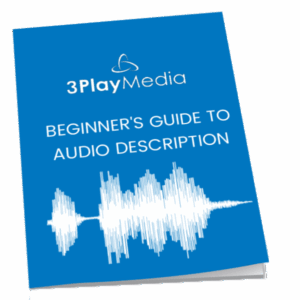Does Your Video Need Extended or Standard Description?
Updated: August 30, 2022
What Is Audio Description?
Audio description paints the perfect picture – audibly – to make visual content accessible to individuals who are blind or low vision. Audio description gives incredible detail and imagery in order to provide low vision viewers with a similar experience to a sighted viewer.

That may sound pretty simple, but there are so many types of video content out there in this world, and all of them are different. The same type of audio description may not work well for both an advanced physics lecture with a professor who talks nonstop, and a movie trailer with very little dialogue. So, what are the options? Glad you asked!
Standard Audio Description
Standard description is when the snippets of description are inserted into the natural pauses of the content being described. This type of audio description works very well for videos that have long pauses in dialogue or that do not contain speech at all. The describer can add concise descriptions of the visual content where space allows, like the example below. You will notice that the original video source plays continuously, and information is described in the pauses throughout. Try playing it with and without description by toggling the AD icon to see how understandable your video is without description.
Extended Audio Description
As I alluded to before, cases like a complicated physics lecture with few natural pauses, but that contain a lot of visual content, can be tricky. With this type of content it is best to use extended audio description.
Unlike standard audio description, extended description does not have to be constrained to the natural pauses of a video. Extended description allows you to pause the video content in order to make room for description, as needed. You will notice that extended description is used in the video below. When you press play, the video and description begin playing. Then, the source video pauses temporarily, while the description continues. After that portion of the description is complete, the video resumes playing again. You will notice this happen in several places throughout the video. Take a look! You can click the AD icon to hear the difference between the described video and the video without description.
Which Level of Service Does My File Need?
When deciding which level of service to choose, the simple answer is that if your video has a lot of space to describe, standard audio description will be just fine. If your video doesn’t have a lot of space, extended is the way to go. While it may be easy to tell for certain files, for others it probably won’t be that black and white. To help you determine which type of description is appropriate for your file, we’ve created a 3Play recommendation feature.
3Play’s Recommendation
When placing an order for audio description, you will have the option to select standard or extended audio description. You will also find the option to select Use 3Play’s Recommendation as the level of service. When you select to use this feature, an automated recommendation will be made based on the amount of audio in your video. If minimal audio is detected throughout the video, your file will process at the standard level. If a lot of constant audio is detected, your file will be processed with extended audio description.
Note: If you are ordering audio description from a file that has already been transcribed, the recommended audio description level will be visible directly on the file. However, if you are ordering audio description at the same time that you order transcription, you will not see the recommended level before the file is complete.
Want to decide for yourself which service is best? Take this two-question quiz to find out.
Whether you’ve decided to go with standard or extended, get started describing today!







